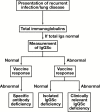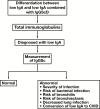The Clinical Utility of Measuring IgG Subclass Immunoglobulins During Immunological Investigation for Suspected Primary Antibody Deficiencies
- PMID: 29126302
- PMCID: PMC5907904
- DOI: 10.1093/labmed/lmx058
The Clinical Utility of Measuring IgG Subclass Immunoglobulins During Immunological Investigation for Suspected Primary Antibody Deficiencies
Abstract
Measurement of IgG subclass concentrations is a standard laboratory test run as part of a panel to investigate the suspicion of antibody deficiency. The assessment is clinically important when total IgG is within the normal age-specific reference range. The measurement is useful for diagnosis of IgG subclass deficiency, to aid the diagnosis of specific antibody deficiency, as a supporting test for the diagnosis of common variable immunodeficiency, as well as for risk stratification of patients with low IgA. The measurement of IgG subclasses may also help determine a revaccination strategy for patients and support patient management. In certain circumstances, the measurement of IgG subclasses may be used to monitor a patient's humoral immune system. In this review, we discuss the utility of measuring IgG subclass concentrations.
Keywords: IgG subclass; common variable immunodeficiency; low IgA; specific antibody deficiency.
© The Author 2017. Published by Oxford University Press on behalf of American Society for Clinical Pathology.
Figures




Similar articles
-
Role of immunoglobulin subclasses and specific antibody determinations in the evaluation of recurrent infection in children.J Pediatr. 1992 Oct;121(4):516-22. doi: 10.1016/s0022-3476(05)81137-0. J Pediatr. 1992. PMID: 1403382
-
Increases in serum immunoglobulins to age-related normal levels in children with IgA and/or IgG subclass deficiency.Pediatr Allergy Immunol. 2007 Mar;18(2):167-73. doi: 10.1111/j.1399-3038.2006.00491.x. Pediatr Allergy Immunol. 2007. PMID: 17338791
-
IgG subclass levels and southern analysis of DNA in primary immunodeficiency diseases including IgG subclass deficiency.Exp Clin Immunogenet. 1994;11(4):173-81. Exp Clin Immunogenet. 1994. PMID: 7857662
-
Immunoglobulin subclass deficiency.Pediatr Infect Dis J. 1988 May;7(5 Suppl):S17-21. Pediatr Infect Dis J. 1988. PMID: 3041356 Review.
-
[IgG subclass deficiencies].Arch Fr Pediatr. 1990 Mar;47(3):213-9. Arch Fr Pediatr. 1990. PMID: 2188632 Review. French. No abstract available.
Cited by
-
Immunoglobulin G4 in primary Sjögren's syndrome and IgG4-related disease - connections and dissimilarities.Front Immunol. 2024 Sep 19;15:1376723. doi: 10.3389/fimmu.2024.1376723. eCollection 2024. Front Immunol. 2024. PMID: 39364411 Free PMC article. Review.
-
Reference ranges for serum immunoglobulin (IgG, IgA, and IgM) and IgG subclass levels in healthy children.Turk J Med Sci. 2019 Apr 18;49(2):497-505. doi: 10.3906/sag-1807-282. Turk J Med Sci. 2019. PMID: 30997788 Free PMC article.
-
Time-related variation in IgG subclass concentrations in a group of healthy Danish adults.Immun Inflamm Dis. 2021 Sep;9(3):1009-1015. doi: 10.1002/iid3.464. Epub 2021 Jun 2. Immun Inflamm Dis. 2021. PMID: 34080322 Free PMC article.
-
Duration of frequent or severe respiratory tract infection in adults before diagnosis of IgG subclass deficiency.PLoS One. 2019 May 21;14(5):e0216940. doi: 10.1371/journal.pone.0216940. eCollection 2019. PLoS One. 2019. PMID: 31112572 Free PMC article.
-
Comparison of the Efficacy of Longer versus Shorter Pulsed High Dose Dapsone Combination Therapy in the Treatment of Chronic Lyme Disease/Post Treatment Lyme Disease Syndrome with Bartonellosis and Associated Coinfections.Microorganisms. 2023 Sep 12;11(9):2301. doi: 10.3390/microorganisms11092301. Microorganisms. 2023. PMID: 37764145 Free PMC article.
References
-
- Fleming DW, Cochi SL, Hightower AW et al. . Childhood upper respiratory tract infections: to what degree is incidence affected by day-care attendance? Pediatrics. 1987;79(1):55-60. - PubMed
-
- Glocker E, Ehl S, Grimbacher B. Common variable immunodeficiency in children. Curr Opin Pediatr. 2007;19(6):685-692. - PubMed
-
- Monto AS, Napier JA, Metzner HL. The Tecumseh study of respiratory illness. I. Plan of study and observations on syndromes of acute respiratory disease. Am J Epidemiol. 1971;94(3):269-279. - PubMed
-
- Buckley RH. Immunoglobulin G subclass deficiency: fact or fancy? Curr Allergy Asthma Rep. 2002;2(5):356-360. - PubMed
-
- Herrod HG. Clinical significance of IgG subclasses. Curr Opin Pediatr. 1993;5(6):696-699. - PubMed
Publication types
MeSH terms
Substances
LinkOut - more resources
Full Text Sources
Other Literature Sources
Miscellaneous

